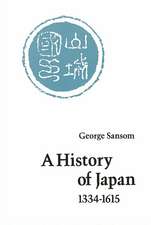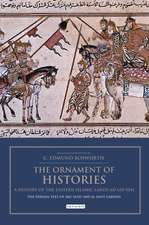Negotiating China's Destiny in World War II
Editat de Hans van de Ven, Diana Lary, Stephen MacKinnonen Limba Engleză Hardback – 2 dec 2014
Breaking with U.S.-centered analyses which stressed the incompetence of Chinese Nationalist diplomacy, Negotiating China's Destiny makes the first sustained use of the diaries of Chiang Kai-shek (which have only become available in the last few years) and who is revealed as instrumental in asserting China's claims at this pivotal point. Negotiating China's Destiny demonstrates that China's concerns were far broader than previously acknowledged and that despite the country's military weakness, it pursued its policy of enhancing its international stature, recovering control over borderlands it had lost to European imperialism in the nineteenth and early twentieth century, and becoming recognized as an important allied power with determination and success.
Preț: 449.89 lei
Preț vechi: 555.42 lei
-19% Nou
86.09€ • 89.38$ • 71.79£
Carte tipărită la comandă
Livrare economică 22 martie-05 aprilie
Specificații
ISBN-10: 0804789665
Pagini: 336
Dimensiuni: 156 x 235 x 23 mm
Greutate: 0.58 kg
Editura: Stanford University Press
Colecția Stanford University Press
Recenzii
Notă biografică
Cuprins
This chapter focuses on France's efforts to maintain a role in East Asian affairs and protect its control of French Indo-China. The chapter traces the decline of French influence to WWI, examines France's efforts to maintain a collective security approach before the outbreak of war, and analyzes how France tried to hold on to Indo-China during the war by following a policy of accommodating Japan while not alienating China ¿ an impossibility.
Mitter traces an important change in UK Foreign Office attitudes during WWII. If before the war the British official mind was contemptuous of China, by the end of the war British Foreign Officials had developed a grudging respect for China and had accepted its status as one of the Big Five Powers. The war with Japan caused official Britain to accept British decline and move on to the unwinding of its imperial role.
China's relations with Tibet have been, and are, a frequent source of difficulty. During WWII, they achieved a nadir, leading the Nationalists to appoint a high level representative who set out, with some success, to improve relations and push back againt growing British influence. Shen Zonglian was successful, but not to the degree that after the end of WWII Tibetan representatives accepted full incorporation into the Nationalist body politic.
During WWII, Stalin's policy in East Asia aimed at drawing Japan into a quagmire in China so as to avoid fighting a war on two fronts. This meant supporting the Nationalists in China, the only force capable of providing serious resistance to the Japanese. However, the Soviets naturally also maintained relations with the Chinese Communists. Yang Kuisong analyzes how the CCP managed the frequently difficult relationship with the Soviets and how Mao Zedong was able to maintain a delicate balance between preserving the interest of the Chinese Communists and accommodating Soviet wishes.
Most scholarship on China's foreign relations during WWII has focused on US-China relations. While this volume breaks fundamentally with that tradition, Diana Lary demonstrates that even a small country such as Canada had a role to play. Individual Canadians such as Norman Bethune were at work in China during WWII, as did missionaries, diplomats, and journalists, while Chinese living in Canada, such as Quan Louie became significant public figures there. In developing a China policy, Canada also moved away from Britain.
China declared war on Japan only after Pearl Harbor, while Japan never followed suit. Tsuchido Akio demonstrates that contrary to generally held opinion, China did not decline to declare war on Japan after 1937 because it feared triggering the provisions of the USA's neutrality laws. Domestic political factors were far more important. By discussing the debates about this contentious issue within Chinese politics, 'Declaring War' provides important insight into the making of Nationalist foreign policy, demonstrating that Chiang Kaishek regularly listened and accepted the advice of his foreign policy advisors and Chinese diplomats.
During WWII, Chiang Kai-shek and Nehru visited each other while India and China began to think through what a post-imperialist Asia might look like. While the strengthening Indian independence movement was a concern for Britain, Chiang Kai-shek worried that the British refusal to accept India independence demands would weaken the Allied position in South and Southeast Asia. Yang Tianshi analyzes the Nationalist policy of expressing support for Indian aspirations for independence while maintain workable relations with the British. He also demonstrates how early enthusiasms on both sides gave way to tensions. WWII did not end with amity between China and India.
Using official sources, rather than memoirs or diaries, Li Yuzhen reconstructs attempts by Chiang Kaishek to secure the direct participation of Soviet forces in China. Chiang appealed to Stalin to order his forces into China on three occasions at moments of great crisis. Although Stalin rejected Chiang's requests, Li Yuzhen concludes that the limited cooperation that the two established, which was based on the national interest of the countries Stalin and Chiang led, nonetheless was important to the defeat of Japan and for WWII in general, making possible the grand alliance between China, the USSR, Britain, and the USA.
Most historians of the Sino-US relationship have focused on such issues as the Stilwell Incident, the Dixie Mission, and Lend-Lease. Liu Xiaoyuan demonstrates that in US foreign policy to China, China's ethnic frontiers was an important issue, just as much as the future of China's former dependencies or tributary states. He also shows that the future of China as a multinational and unified country was important US State Department concern. He thus shows that US strategy was far more sophisticated and comprehensive than earlier analyses have allowed us to conclude.
China's Northeast (formerly known as Manchuria) was contested territory since the late 19th century, fought for by Russia, Japan, and China. It became a Japanese client state in 1932. Until WWII, it was by no means clear that China would end up controlling the area. Nishimura demonstrates how Northeasterners mobilized support in Chongqing for their struggle against the Japanese and how the Nationalists came to invest so much political capital in the area that they could not abandon it after the war, although their military and governmental weakness possibly made that the better option.
Wu Sufeng demonstrates that the policy of the Nationalists toward post-war Japan was based on the principle of 'repaying aggression with kindness', in stark contrast to US and British approaches. Wu argues that in pursuit of this policy, Chiang Kaishek encountered many setbacks and had to put up with dismissive attitudes of his two major Allies which resulted in China's exclusion from major Allied conferences in the last year of WWII. Chiang Kaishek even had to plead for the inclusion of China as one of the three countries demanding Japan's unconditional surrender in the Potsdam declaration. However, on such key issues as the position of the Japanese emperor and wartime reparations, Chiang's views were nonetheless influential. His careful manouevering also ensured that China did emerge out of WWII as one of the victorious Allies.
Yang Weizhen's examination of Sino-French negotiations about Vietnam complement Bastid-Bruguiere's account of the fading French influence in East Asian international relations. After Japan's surrender, Chinese troops entered Vietnam; Japanese commanders handed over to Chinese officials. However, the Chinese retreated quickly from Vietnam, in part because they did not have the forces to occupy Vietnam and were already overextended. Conflicts between the central government and local powerholders in south China meant that it was in the interest of the central government to halt China's engagement in Vietnamese affairs. Moreover, the Chinese Foreign Ministry had maintained good relations from 1944 with the Free French of Charles de Gaulle, whom Chiang Kaishek had assured that China had no interests in Vietnam. Chiang needed his collaboration in securing the ending of French privileges in China. And so, France ended the war in Vietnam, although Ho Chi Minh had already achieved major succeses.
Van de Ven argues that the 1952 Peace Treaty between the Republic of China and Japan was less a peace treaty than one of a series of US-inspired treaties to contain communism in East Asia. It was important because it meant that the Nationalists would be regarded as one of the victorious allies; because it turned Japan away from concluding an agreement with the PRC and steered it toward Taiwan and other states in South and Southeast Asia; and, finally, because it would form a cornerstone of a political order in East Asia which remaind in place today. Van de Ven demonstrates that many issues that bedevil interstate relations in East Asia, such as the status of Taiwan, have their origins in the negotations leading up to this treaty.

















